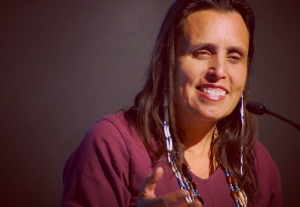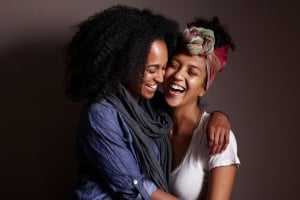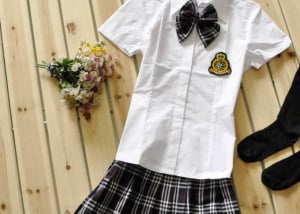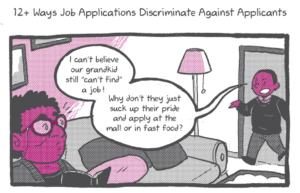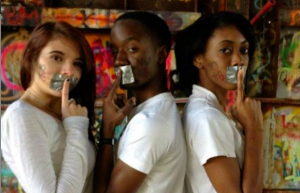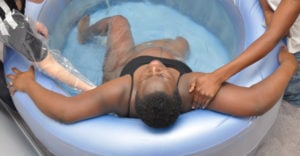An international beauty contest recently wrapped up with a new winner crowned and honored before thousands of spectators.
But these contestants weren’t stuffed into swimsuits or covered with faux tan in homage to the Western ideal of how a woman’s body ought to look, nor did their talents lend themselves to the quaint or arbitrary. Or cup music.
That’s because this contest was Miss Indian World – a weeklong indigenous competition focusing on culture and tradition that ended its 31st year at the Gathering of Nations Powwow in Albuquerque, New Mexico, in late April.
Twenty-one women from indigenous communities across the globe showcased talents ranging from tribal language mastery to nation-specific know-how in clothing, ritual practices, storytelling history, and more.
Admittedly, I think cup music is pretty neat, but not as awesome as highlighting your tribe’s coming of age ceremony, demonstrating your awesome lacrosse skills, or presenting history within the traditional framework of storytelling.
The beauty in this contest is inherently tied with indigenous survival. It’s about how, despite systemic attempts to wipe out indigenous life, it has endured and evolved in many contemporary ways.
This concept of indigenous beauty coincides with how I – and I think how many indigenous women – view feminism.
I’m often asked in what ways I consider myself a feminist. I know many people, including those who identify as feminist, view the movement within an issue-specific framework, like equal pay or ending gender-based violence.
But for me, belonging to the Očéti Šakówiŋ (or Seven Council Fires, the overarching societal structure of my Lakota people) and feminism are one in the same.
Dismantling colonized concepts of justice and living is the same thing as fighting the kryiarchy.
When Manifest Destiny and colonization swept across the prairie, it brought patriarchal notions of dominance with it. I know our world before white people wasn’t perfect. But all of our histories indicate we had the whole interpersonal relationships thing down as experts in communal, family-centered, and sustainable living.
We had places in our societies for gender-fluid people, leadership roles for both men and women, and concepts of justice based on equity, not profit.
Ownership was a foreign idea; gifting to others – the ability to give to others, whether it was a tangible object, time, or emotional energy – was a huge source of honor.
While some of our traditional ways dimmed in the shadow of Western expansion, we’ve retained many of these values today.
Indeed, Native women continue to hold those leadership roles in our community; not necessarily in a political sense, but definitely in roles that matter to people who need to be lifted up.
We’re talking mothers and grandmothers, activists and advocates for environmental justice and sustainability, racial representations, active lifestyles, academia, art, and more.
It’s important to note that while I’m going to showcase some of these women on a feminist blog and write about them in a feminist context, they are not being identified as feminists. Some of them have major issues with the feminist movement, as we’ll discuss below.
However, each one represents – by action, by word, or by work – the contemporary places Native feminism exists today.
These women, like the women who compete in the Miss Indian World contest, prove beauty isn’t about how well you rock an outfit (although that’s cool and all, and more power to you for expressing yourself in ways that are meaningful to you).
For me, beauty incorporates culture, talent, traditions, and pretty much anything else that can be used to enhance life for Native people.
To me, these Native women are beautiful – wiŋyan wašté.
1. Winona LaDuke
In addition to promoting traditional sustainable living practices for indigenous communities, LaDuke focuses on climate change, renewable energy, sustainable development, food systems, and environmental justice, and has done so for decades.
You can read about – and support – LaDuke’s efforts on her website, Honor the Earth.
I’m featuring the Anishinaabe activist because my family and I met her in person in April, when she was in Colorado Springs to discuss divestment, explain why defeating oil pipelines today can mean a better quality of life generations down the road, and encourage folks to produce and cook (not just heat up) their own food.
It was with this last topic LaDuke said something about feminism I think is important for everyone to consider, because it highlights a very real issue many women of color have with feminism in that it dismisses many of the values WOC hold dear.
LaDuke said feminism took women away from cooking, when in the mid-to-late 20th century it encouraged them to stop slaving away in the kitchen and instead enjoy restaurants and meal delivery.
She also said feminism helped to create a society that saw soil as dirty and not worth an enlightened mind’s time.
I know these sentiments may rankle feminists for being a super-simplistic way to explain a movement that encouraged women to choose their own adventure, including the option to step away from cooking and house work as roles demanded of them by the men in their life.
But I totally get how LaDuke and others would think feminism is anti-cooking and anti-dirt, especially in how it’s presented by white, middle class women.
I’ve often had other feminists scoff at my dedication to children, family, and caregiving. For them, feminism is about independence, and they don’t realize their statements of “Oh, I could never be tied to a kid or family” are hurtful and ignore many of the issues Native communities face.
But I’m hoping LaDuke will reconsider the many ways intersectional feminism can uplift and enhance the causes she champions.
Because there is room in feminism for dirt, diapers, and cooking, just as there is room for childless singletons who enjoy condo-living and takeout.
2. Pura Fé
I’m sorry to admit I was only just introduced to the music of Pura Fé this year when I was assigned to write a profile of the Tuscarora/Taino musician from North Carolina for Native Peoples magazine.
During the interview to learn more about her latest album, Sacred Seed, it became clear music is just one aspect of Pura Fé’s impact on the world around her.
To be sure, her music is gloriously raw and rumbling, with soulful sounds of indigenous blues paired with Tuscarora chants, hand drums, and lap slide guitars, which all come from the 55-year-old musician.
But it’s Pura Fé’s subtle activism that truly inspires me.
During her performances, Pura Fé told me she tries to educate her audiences with slideshows highlighting major issues in Indian Country, including missing and murdered indigenous women and climate change. Even the title song off her latest album references indigenous history mixed with an anti-GMO vibe. Check out one of my favorite Pura Fé pro-women song collaborations here.
“I’m often labeled as an activist,” Pure Fé states in a quote on her website. “In fact, I place myself in the time-honored perspective of someone who accepts to bear the responsibilities inherited from my ancestors. It urges me to fight for the rights of indigenous people and denounce the threats to the environment, starting with oil and shale gas corporations.”
She broke that further down for me during our interview:
“For me, music is a tool to help our people in our communities and all the issues we fight,” she said. “This is our home, and we’re all we got. I think what Native artists have is a huge tool to educate. It’s a platform, and a political arena to spell stuff out and lift stuff up. We’re an important voice. It’s important what we say and do.”
3. Shoni Schimmel
I played basketball in high school and college, but from the standards set by Atlanta Dream guard Shoni Schimmel, I might as well have been dribbling a pumpkin with my sneakers tied together.
My daughter, husband, and I got to meet Schimmel at the Denver March Powwow a few months ago. I’m not even a little bit ashamed to say I stood in a really long line and paid a small fortune to talk to the basketball star and take a selfie with her.
What makes Schimmel such a powerhouse is a mix of humbleness, role modeling, athleticism, and realness. There’s a reason hers is the best-selling WNBA jersey.
At 23, the Thrilla from Umatilla been on indigenous radars since she was in high school, when a film crew followed her and her family for the 2011 TLC documentary Off the Rez.
Then, she and her sister, Jude, took March Madness 2013 by storm for the Louisville Cardinals, which made it to championship game that year.
Watch this clip of the 5’9” Schimmel against Baylor’s 6’8” Brittney Griner and be amazed.
I remember our family – and thousands of Native families across the country – watching the tournament that year and being totally sucked in by the Schimmel sisters’ presence both on and off the court.
These were athletes – people who shaped their minds and bodies into the best they could be – Native youth (and adults!) could look up to.
By the way, that small fortune I paid to meet Shoni helps the star bring basketball skills and motivational clinics to Native communities to inspire youth across the country, an endeavor not many professional athletes bother with and I’m happy to support.
4. Suzan Shown Harjo
Harjo became one of my heroes after I started advocating against racist sports mascots in high school.
Harjo, of Cheyenne and Hodulgee Muscogee heritage, has waged war against the Washington pro football team logo and mascot and the racist images of other franchises since the 1980s. It’s because of people like Harjo that this issue is even discussed in mainstream media today.
But like all the women described here, the 69-year-old’s impact goes beyond just one aspect of indigenous activism.
Harjo is president of the Morning Star Institute, a DC-based nonprofit lobbying for the return of tribal lands and sovereignty. She’s also a prolific writer and one of my favorite poets.
In presenting Harjo with the Presidential Medal of Freedom last November, President Barack Obama summed up Harjo’s efforts nicely, as reported by Indian Country Today Media Network:
“Through her work in government and as the head of the National Congress of American Indians and the Morningstar Institute, she has helped preserve a million acres of Indian land; helped develop laws preserving tribal sovereignty; she’s repatriated sacred cultural items to tribes while expanding museums that celebrate Native life… Because of Suzan, more young Native Americans are growing up with pride in their heritage and with faith in their future. And she’s taught all of us that Native values make Americans stronger.”
***
There are so many ways embracing my Lakota culture and feminism have positively impacted my identity, but especially in how I see myself and my role within my home and community.
There is room within intersectional indigenous feminism to advocate for all marginalized voices, whether they’re fighting against racist mascots or Big Oil companies, advocating for youth or missing and murdered indigenous women, or modeling healthy lifestyles.
The courage to continue pushing forward with these issues and countless others, despite continued systemic oppression and marginalization, is what I find truly beautiful about indigenous feminism.
What is beauty? The 2015 Miss Indian World, 22-year-old Cheyenne Brady, who is Sac and Fox, Cheyenne, and Tonkawa, said it comes from the heart.
“When I think of beauty, I think of my grandmas and the work that they do. They have their specific roles within ceremony. They’re culturally active. That’s beautiful to me,” Brady said in a recent interview with Indian Country Today Media Network.
I couldn’t agree more and hope other young indigenous people look to role models like those noted here as examples of empowered, community-based feminism.
[do_widget id=”text-101″]
Taté Walker is a Contributing Writer for Everyday Feminism. She is a Mniconjou Lakota and an enrolled citizen of the Cheyenne River Sioux Tribe of South Dakota. She is a freelance journalist who lives in the Colorado Springs area. She blogs at Righting Red and can be reached on www.jtatewalker.com. You can check her out on Twitter @missustwalker.
Search our 3000+ articles!
Read our articles about:
Our online racial justice training
Used by hundreds of universities, non-profits, and businesses.
Click to learn more
Most Read Articles
- « Previous
- 1
- …
- 30
- 31
- 32


